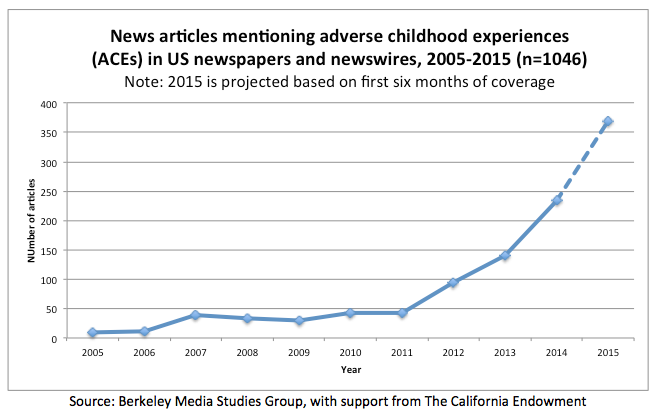ACEs in the headlines: Coverage takes off in 2015
by: Alisha Somji
posted on Wednesday, July 29, 2015

Scholars and practitioners have made tremendous strides in making news about the trauma caused by several types of adverse childhood experiences (ACEs) that lead to damaging physical, mental and social health consequences. But why does this matter? Why should ACEs be in the news?
At Berkeley Media Studies Group (BMSG), we study how the news media characterize health issues. What the public learns about ACEs — apart from personal experience — comes through a filter of what appears in the media. Journalists, in turn, play an important role in setting the agenda for public policy debates by deciding what to report on, and what not to cover. If news coverage doesn’t include ACEs and the root causes that foster childhood trauma, it will be harder for policymakers and the public to make connections to policies that can prevent ACEs.
The good news is that we are seeing an increase in coverage about childhood trauma. If the trend continues, we can expect to see about 14 times as much news on ACEs this year than we did a decade ago. The increase in news over the years is important because it means that more people will become familiar with the concept, why it matters, and, if the coverage is thorough, what we can do about it. The jump in the number of stories is a testament to the work of those connected to ACEsTooHigh and ACEsConnection.
However, even with that good news, there is more to do. Public conversations about ACEs are still underrepresented compared to other health issues. For example, there was approximately the same amount of news coverage mentioning child sexual abuse in just 10 days in 2015 (June 22-July 1, 2015) as there was for ACEs in the last 10 years.
Still, BMSG’s research indicates that there are many reasons for optimism in ACEs coverage to date. In addition to the growing number of articles, our preliminary data shows that unlike most public health issues, when childhood trauma or ACEs is named in the news, systematic solutions about prevention and intervention are also included.
So what should prevention advocates do? Continue to makes news about childhood trauma through opinion spaces such as op-eds and letters to the editor, so prevention voices can shape the conversation about ACEs and what should be done to prevent and lower the risk of trauma’s consequences in communities.
Stay tuned for an upcoming analysis from BMSG that examines how ACEs are portrayed in national, state and online news along with an analysis of how trauma could be covered in business and education news.
This blog originally appeared on ACEs Connection.



